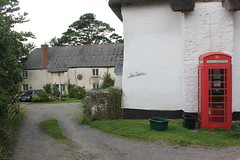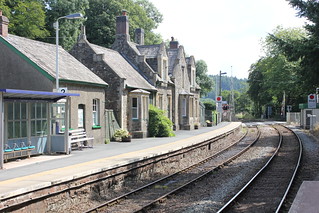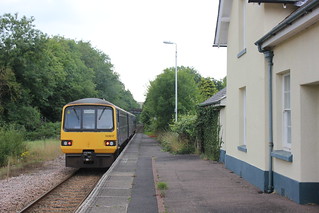Synopsis: A visit by bicycle to Marker’s Cottage and Clyston Mill, in the village of Broadclyst, both National Trust properties. A picnic lunch in the churchyard, which also served as a bike park.
I’ve visited Killerton House and Gardens (NT) on many occasions. And I’ve known that there are three ‘satellite’ properties owned by the National Trust (see Killerton’s ‘places nearby’), which I’ve long intended to visit, but time has always always thwarted me. Today I intended to visit all three, but once again the clock was against me, and I got to just the two, Marker’s Cottage (NT) and Clyston Mill (NT). The third, Budlake Old Post Office (NT), will have to wait until a future date.
If it’s my intention to visit Killerton, I nearly always cycle, as it’s such an easy and safe cycle route. Today was no exception. On reaching Broadclyst I had thought I might picnic in one of the nearby fields, but the grass was wet, so I thought better of it. I made my way to the local churchyard where, as I’d expected, there were to be found a number of benches. I picked one by a wall facing into the sun and sat in the peace and tranquillity of the churchyard to eat my lunch.
With no particular plan in mind, I opted to secure my bike to one of the benches in the churchyard. I then chose to walk to Marker’s Cottage (Grade II* Listed), which I’d noted as I passed it earlier on my way into Broadclyst. It was only a five minute walk from the church.

The cob cottage is painted in the Killerton estate colour of yellowish orange. It is a building of some considerable size suggesting this had been the property of a family of wealth. It is thought that the money came from the woollen trade, and the nautical references within the house, situated far from the sea as it is, are considered possible indicators of the international trade in goods that was once taking place.
On approaching the entrance to the house a notice requests that you ring the bell to gain access. A tug on the quaint bell pull soon resulted in a warm welcome into the house. I entered via a small vestibule, with the main hall being to the left, with a small living room to the right, to which I was led. The steward told me a little of the history of the house. Apparently the reason it is referred to as Marker’s, is that the earliest existing record of an inhabitant is one Sarah Marker in the early 18th century, although the house is thought to be a good deal older than that time.

The house originally had only one floor, the ground floor. The entrance passageway leads into the main living quarters, the main hall where the fire would originally have been in an open hearth in the middle of the room. This fire provided heat for the house and was also where food would have been prepared. The inglenook chimney was added at a later date.

One of the main attractions of the cottage is the oak panelled wall that divides the hall from the parlour. Four of the original oak panels survive, with two having been replaced. The main reason for their survival was the fact that this wall had been covered in lathe and plaster which protected it. The oak panels and columns had been painted, paintings which survive. Those in the hall are somewhat darkened by the smoke from the fire, but those in the parlour are very well preserved.

The downstairs rooms have been simply furnished with a substantial amount of old country furniture. The furniture includes a settle, chairs, oak chests and tables. The house had been divided into two, to form two worker’s cottages, which was how it was when it became part of the Acland estate. During Victorian times minor improvements were made such as the addition of a chimney in the parlour, and an extension added to the rear of the cottage.

The first semblance of an upper floor that was added to the house was a single and simple bedroom space, possibly with a simple ladder to reach it. Subsequently the upper floor was extended across the whole house, subdivided into rooms, and a proper staircase introduced. The old stair tower has been rebuilt, up which I walked to the upper floor, at the top of which I entered the main bedroom. The bedroom has been furnished with furniture from the Victorian age.

Windows at the rear of the house are mid-floor, belying the fact there was no floor division originally. From the upper floor it is possible to look through a hatchway to the attic space and see the original beams and rye thatch blackened from the time when there was no chimney in the house.

As interesting as Marker’s is, I needed to moving on if I was to spend time at Clyston Mill and attached Miller’s Cottage (Grade II Listed), so I said farewell to the very friendly steward and made my way back across Broadclyst. Clyston Mill can be reached via a path from the rear of the churchyard, a route that is signposted. Crossing a field that once contained the old mill pond, now only sheep, I reached the mill.

Clyston Mill is well preserved, complete with all its internal milling machinery, which is working order. Although milling wasn’t taking place today, the mill wheel was turning, apparently with the help of an unseen electric motor. I was informed that the problem today was the fact that there had been a storm a few days previous, which caused the level of the River Clyst to rise dramatically, and this caused damage to the sluice gate, thus making it impossible to maintain the water level at sufficient height to drive the waterwheel.
Clyston Mill has always suffered with waterpower problems. During Victorian times a steam engine was installed such that the mill might continue to operate when there was insufficient water from the River Clyst to drive the mill. The housing for this old steam engine still exists, and today houses the electric motor, but the original steam engine has long gone. An interesting fact from the National Trust steward: the steam engine, in addition to driving the milling wheel, was also used to power a pump that supplied water to the village centre along lead pipes (see photo: ‘Broadclyst to Cowley via Killerton 001’).
On the upper floor can be seen all the milling machinery, including three mill wheels. Two are operational, one is held open so that it can be inspected. The tenant works as miller, and there are days when the milling can be seen in action. The flour that is ground is made available to the kitchen at Killerton. And the organic Real Food shop in Paris Street, Exeter, is also a customer for the flour.

Climbing one more floor, I entered the main storage area for the flour produced at the mill. There is a mechanical sack hoist that is capable of lifting the sacks of flour to this floor. There is a lovely set of old milk bottles in a series of display cabinets along the walls. I’d forgotten the fact that each dairy, and there were many of them, had their own shape of milk bottle, and their own branding. It harks of a world far removed from the standardised plastic milk containers of today.

There is also a quern, a hand propelled milling wheel, the oldest form of milling, used throughout the world for thousands of years. I’ve a feeling a feminist passed this way, as someone has objected to the wording on the information panel (look closely and you’ll see what I mean).

One thing that made me smile, was that I read on one of the information panels that the milk trade was a ‘cut throat business’. Recent reports in the press of disputes between farmers and the supermarkets over the price they were offered for their milk caused me to think some things haven’t changed so very much.
I’d thoroughly enjoyed my visit to these two National Trust properties. Small they might be, but they’re packed full of interesting history, and are simply charming. And Budlake Old Post Office remains to be seen another day.
Cycle Statistics:
Total Distance: 17.0 km / 10.5 miles
Elapsed Time: 5hrs 32min
Moving Time: 2hrs 19min
Buses: (none)

















































